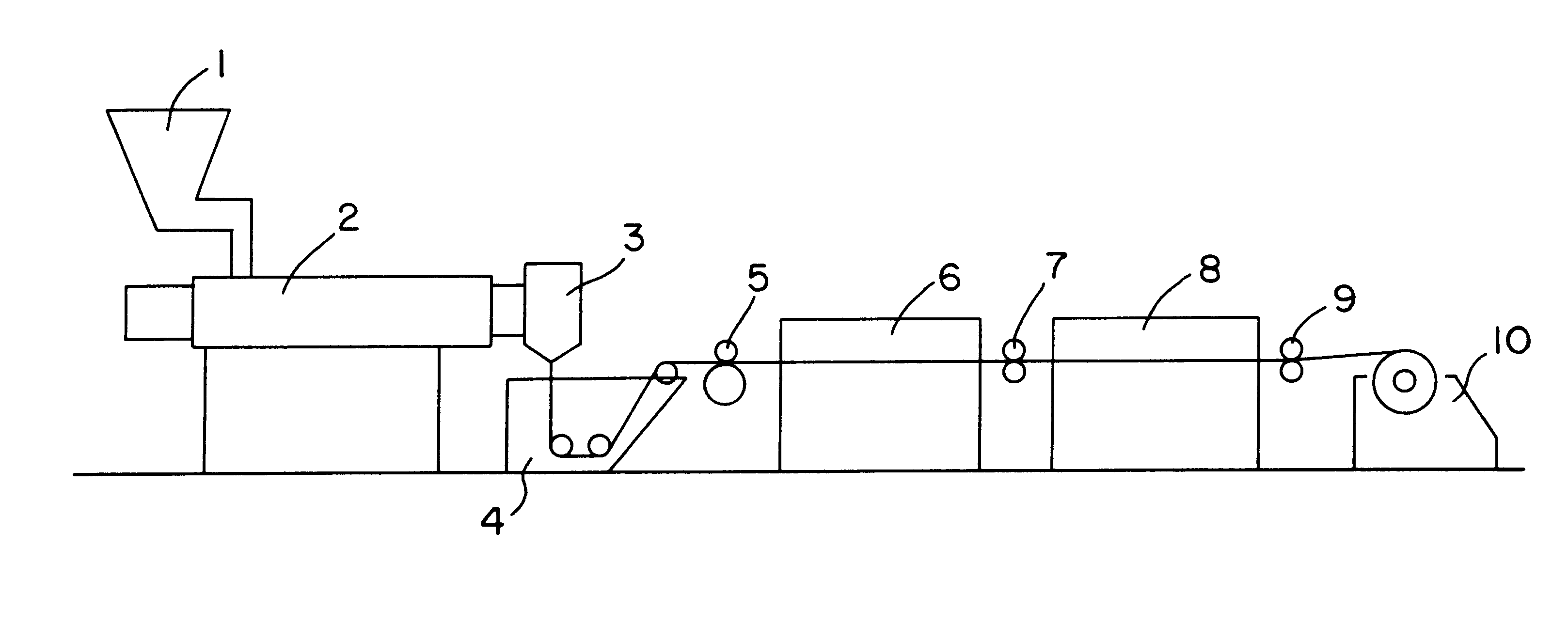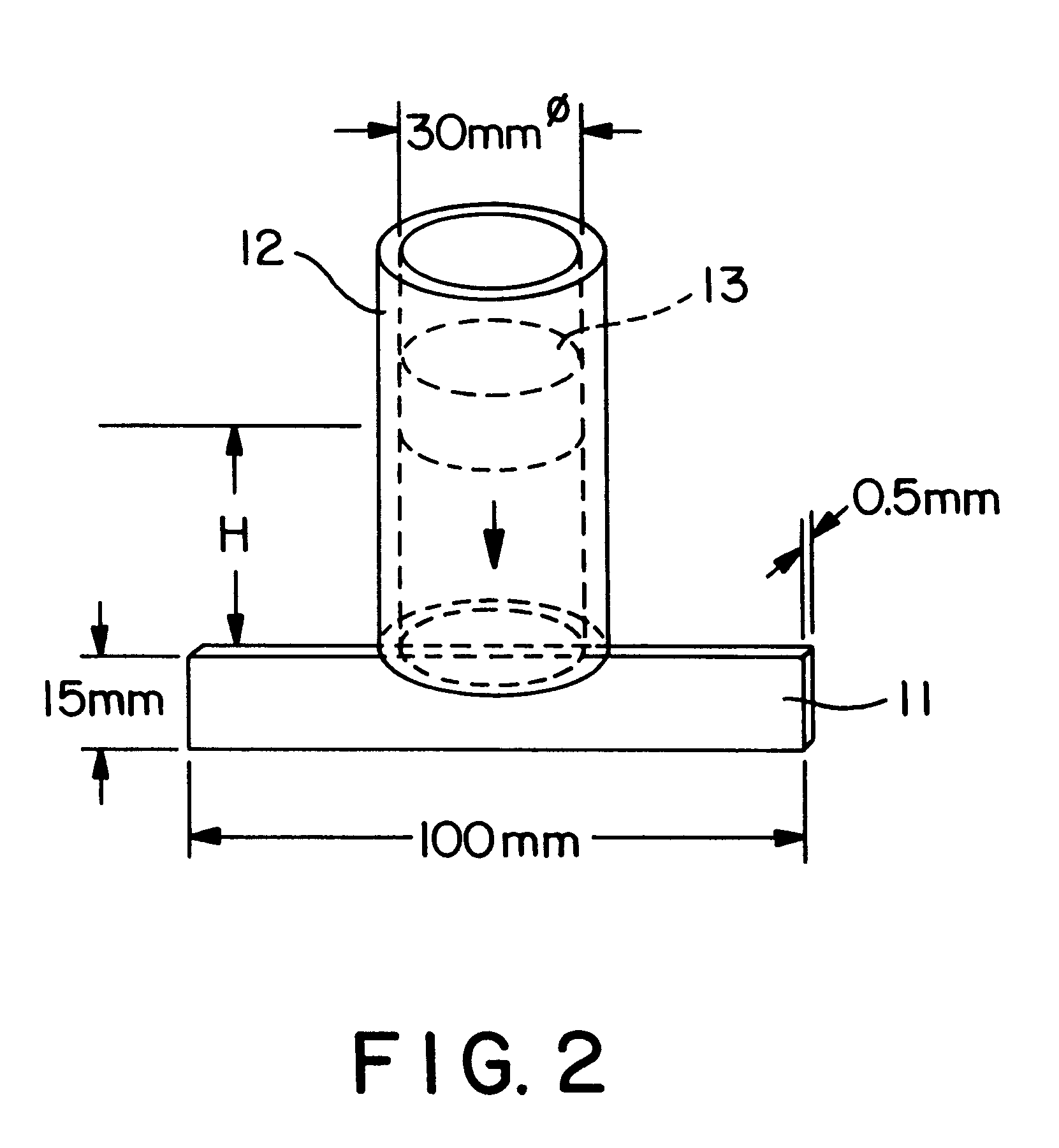Band-shaped article and production process therefore
- Summary
- Abstract
- Description
- Claims
- Application Information
AI Technical Summary
Benefits of technology
Problems solved by technology
Method used
Image
Examples
example 1
Carefully selected ground flakes of an used polyethylene terephthalate container (PET bottle) were used as a raw material. The ground flakes had an intrinsic viscosity of 0.62 and were large in size enough to pass through 10-mm meshes. The ground flakes were dried at 140.degree. C. for 17 hours.
Bisphenol A diglycidyl ether [Epicote 815 of Yuka Shell Epoxy Co., Ltd.] was used as a bifunctional epoxy compound and manganese acetate (tetrahydrate) was used as a catalyst.
The above ground flakes, the bifunctional epoxy compound and the catalyst were supplied in amounts of 100 parts by weight, 0.35 part by weight and 0.05 part by weight, respectively, to an end portion of an extruder by a hopper equipped with a stirrer. A quantitative feeder was furnished at the lower part of the hopper.
The extruder used was a type of unidirectional twin-screw having an L / D of 35, a compression ratio of 1:3 and a screw diameter of 60 mm and had two vent ports and a gear pump at a tip end portion. This extr...
example 2
The same ground flakes as in Example 1 were dried at 140.degree. C. for 17 hours before used. 100 parts by weight of the ground flakes, 0.36 part by weight of bisphenol A glycidyl ether (Epicote 815) and 0.06 part by weight of manganese acetate (tetrahydrate) were mixed together, and the resulting mixture was dried at 120.degree. C. for 7 hours.
The above mixture was supplied to a twin-screw extruder having two vent ports and extruded at a cylinder temperature of 265.degree. C. (residence time of 3 minutes), and the polymer was discharged from a die having the same shape as in Example 1. The discharged molten product was stretched in the same manner as in Example 1 except that the stretching ratio was changed to 5.3 times, and heat set to obtain a band-shaped article. The results are shown in Table 1.
example 3
The same ground flakes as in Example 1 were dried at 140.degree. C. for 17 hours, stored in a pail can whose inside was substituted with nitrogen, and then, used as a raw material polyester. 100 parts by weight of the ground flakes, 0.35 part by weight of bisphenol A glycidyl ether (Epicote 815) and 0.05 part by weight of manganese acetate (tetrahydrate) were mixed together. This mixture was supplied to a twin-screw extruder having one vent port and extruded at a cylinder temperature of 265.degree. C. (residence time of 4 minutes), and the polymer was discharged from a die having the same shape as in Example 1. The discharged molten product was stretched in the same manner as in Example 1 except that the stretching ratio was changed to 5.3 times, and heat set to obtain a band-shaped article. The results are shown in Table 1.
PUM
| Property | Measurement | Unit |
|---|---|---|
| Temperature | aaaaa | aaaaa |
| Temperature | aaaaa | aaaaa |
| Weight | aaaaa | aaaaa |
Abstract
Description
Claims
Application Information
 Login to View More
Login to View More - R&D
- Intellectual Property
- Life Sciences
- Materials
- Tech Scout
- Unparalleled Data Quality
- Higher Quality Content
- 60% Fewer Hallucinations
Browse by: Latest US Patents, China's latest patents, Technical Efficacy Thesaurus, Application Domain, Technology Topic, Popular Technical Reports.
© 2025 PatSnap. All rights reserved.Legal|Privacy policy|Modern Slavery Act Transparency Statement|Sitemap|About US| Contact US: help@patsnap.com



